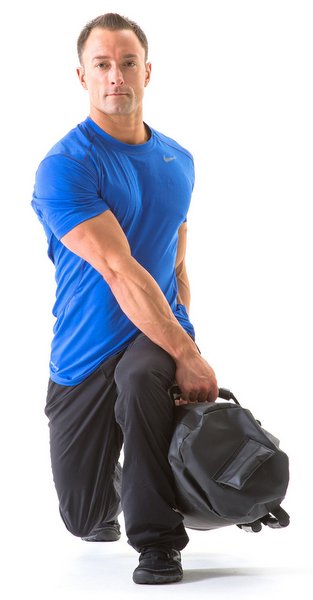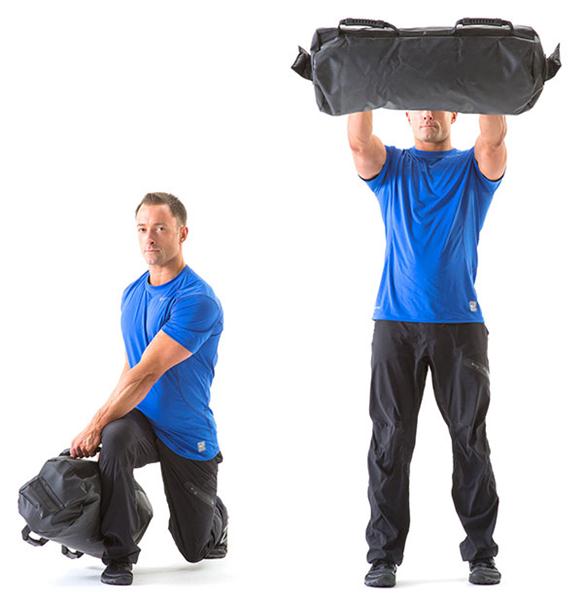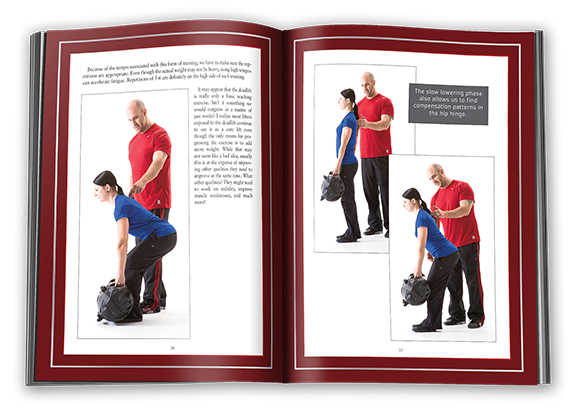How to Meet the Challenges of Group Training and Programming with the DVRT and Kettlebells
by Joe Chalakee, RKC, Master DVRT with Josh Henkin, SrRKC, DVRT Creator, CSCS

Josh Henkin: Joe, can you give us a bit of your history in athletics, and how you got into RKC and DVRT?
Joe Chalakee: Like most kids growing up I played baseball, softball, football, and some basketball. We mostly played with friends in the street or at school. I played in little league, and the local football league, but it was never much fun when I played team sports—unless I was with friends at the park, in the street, or basketball pickup games.
When I was 12, I was introduced to the new sport called bicycle motocross (BMX). That’s when sports changed for me, and I had my first ever BMX race that year, too. I lost, but it was fun!
I raced a few more times that year, but was cut short because the friend who introduced me to racing cut me off. His parents wouldn’t take me with them to races because I started beating him every time we raced each other. My BMX career went "on hold" for about two years before I got back to it.
In my first year of high school, I joined the football team. Our high school was a big football powerhouse at that time. And like every other kid on the team, I wanted to play varsity. I had to get stronger, so after practice I hit the weight room, then would finish up with sprints. I was quick on my feet for a kid that weighed a buck eighty five—the track coach even tried to recruit me for track in the off season. We were doing long jumps in gym class, and after a few jumps he got out the tape measure and saw that I was 3ft from the school record. Then he asked how fast I was in the forty (I remember it being 4.6 seconds) and if I might consider joining the track team. From then on, he asked me every day because I could run, jump, and he was looking for good athletes.
That summer, a new BMX track opened closer to where I lived and I could ride my bike there to race. I raced all summer and forgot all about football until school started. Back in school I played football for about two weeks, then walked in to the coach’s office to turn in my equipment. After school that day I went BMX racing and never played football again.
I raced at expert and pro levels, but never raced as a beginner or novice. I was good, but not great, but I was doing what I wanted to do.
When I stopped racing, I needed a new outlet, so I started training Shotokan Karate. It was something I always wanted to do, and I would eventually earn my black belt. My first Shotokan instructor also taught self-defense at the local community college. He introduced me to Brazilian Jiu Jitsu in 1993, and I started training. I still train BJJ when I have time.
But, I injured my knee and would need to have surgery. A month later, I went to the PAN BJJ Tournament to watch friends compete. While talking with one of my friends who was competing, I asked how he was cross training for BJJ. He had been using kettlebells with another one of our friends, Felicia Oh, a BJJ Black Belt and an RKC at the time. Later, after my doctor cleared me to train again, I purchased a
12kg kettlebell, the
Enter the Kettlebell book and
DVD.
Soon I started to learn the kettlebell swing which was easy for me since most of the tension to create power was similar to Shotokan which I had been training for over 10 years. One night after BJJ Class I was talking with John Spazzano and mentioned I was training with kettlebells. He recommended that I train at Kettlebells Los Angeles with Dr. Mark Cheng. A week later, I started training at KBLA and began to prepare for the 2008 RKC.
I was looking for tools to improve my strength and conditioning, since I couldn’t have more mat time because of family and work. I needed to improve my overall conditioning, and I found the answer with kettlebells. I liked the kettlebell so much that I started looking for other unconventional training tools. After searching online, I found the Ultimate Sandbag (USB).
At first I purchased a Burly Bag, thinking that’s all I need—BIG, HEAVY, and FAST! Then I came to the realization that I needed a smaller USB to learn how to use it, and bought a Power USB, which I started using more in my training.

I met you in August of 2010 at the RKC in La Jolla. I introduced myself when you were in the gym doing paper work. In 2011, I attended your
DVRT Level One certification in Los Angeles. It was a great experience, and I learned a lot that weekend. And found a new kind of soreness! I started adding the DVRT System to my own training as well as my clients’ training.
Josh Henkin: I know this became a second career for you, too. How did you make that leap and what advice would you give to others considering a similar change?
Joe Chalakee: While I was in college, I wanted to be a trainer but never took the steps to do it. In March 2006, I was laid off from my software consulting job at one of the largest software companies in the world. In August 2008, I attended and passed the
RKC, a few months later I started Kettlebells South Bay. I had a background in teaching group classes from my Shotokan training days when I taught the kids classes at one of the dojos where I trained. My instructor, James Yabe, would sometimes ask me to cover classes for him, too. Normally that task would go to the most senior student, or the highest ranking, but I wasn’t either of those things. Teaching just came easily for me.
I recommend teaching in the same way that you like to learn. That is how I approach teaching Shotokan, and my group classes. Everyone learns differently. A cookie-cutter approach is not for everyone. Also, be sure to enjoy what you do—it makes a huge difference. I love what I am doing.
Josh Henkin: At first glance, some people might think the RKC and DVRT are the same thing, how would you explain the differences?
Joe Chalakee: They are different. Starting with the obvious, the RKC uses kettlebells—"cannonballs with handles". The
DVRT uses the Ultimate Sandbag, which is a specially designed bag with sand and handles!
With kettlebells we have forward, backward, up, and down movements. Keeping it simple, the up and down movements are get-ups, deadlifts, presses, and squats. The forward and backward movements are lunges, and get-ups. Swings, cleans and snatches are the ballistic movements.
The DVRT System has many of the same movements plus a rotational component that fills in the gap of most training systems.
They are similar in that they both start by teaching the deadlift, and build from that movement. If you can’t deadlift, you can’t swing a kettlebell very well. With DVRT, you use the deadlift to build the power clean, high pulls, and the next progressions.

Josh Henkin: What results have you seen with your clients?
Joe Chalakee: They have stronger cores, improved stability, have lost body fat, and most importantly they have gained overall strength.
At the end of last year, a client came in to train with kettlebells who had been training on his own at home. He tried the free class we offer, thinking that he’d learn how to swing and then continue training at home. But, it was a little harder then he realized. At first, all of his lifts were from his lumbar region. Deadlifting a 24kg kettlebell, he was lifting with his lower back. At first, he couldn’t hold a plank for more than ten seconds or really get into a decent plank position. He signed up with me and started training three days a week. After 5 classes and little progress, we talked about changing it up with the DVRT Ultimate Sandbag.
For the next three weeks, he only did Ultimate Sandbag workouts. He practiced tall kneeling presses, tall kneeling around the worlds, front hold good mornings, and lying down presses—and that was just the warm up! His workouts included isometric holds, clean and presses, bear hug squats, and most importantly—deadlifts. Later we added rotational lunges and high pulls. The last thing I had him do was bag drags. On the fourth week, we did a new DVRT workout, the finisher was twenty seconds of work, ten seconds to transition between planks and kettlebell swings for four rounds. This time, he could hold a plank, and could do kettlebell swings with a hip hinge—without using his lower back. For the previous four weeks, at the beginning of each DVRT workout, he kept complaining about how sore his core was—but he also mentioned how much stronger he felt.
Josh Henkin: What are the biggest challenges you have when integrating these tools for groups, and how do you overcome them?
Joe Chalakee: The biggest challenge is working with clients at different fitness levels. The newer clients are interested in training with the DVRT Ultimate Sandbag. They like what we are doing at Kettlebells South Bay so they want to try it out, but there is only one DVRT Ultimate Sandbag class on the schedule. Some are a little afraid because they are newbies, but once they come to their first class, they see that we start from the beginning just like a DVRT workshop. They learn techniques slowly, it’s a workout just from learning. I like to say that it's, "Easy to learn, but a much harder workout!" With kettlebells, the average client takes a little longer to learn the swing. Right now, I have a new client who only comes to the DVRT Ultimate Sandbag class, even though he originally came to our gym to learn kettlebells.
We integrate the DVRT Ultimate Sandbag and kettlebells for advanced clients. When clients know the basic six kettlebell techniques and basic DRVT techniques, we will mix it up.
The other challenge is programming. We have to make sure we don’t have a kettlebell press and a DVRT clean and press in the same workout. Workouts might be mostly kettlebells and a DVRT USB exercise, or it could be a mostly DVRT USB workout with added kettlebell swings. A workout I like is one that combines the DVRT clean and press, then double
kettlebell staggered stance front squats (switching the stance at the half way point—if you do six reps, do three and three). Next, we do DVRT bent-over rows for six to eight reps for four to five rounds. We finish with 10 kettlebell swings followed by 10 DVRT bag drags, take twenty seconds rest, and repeat for five rounds.
Back